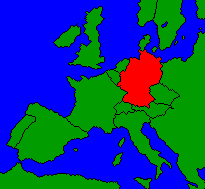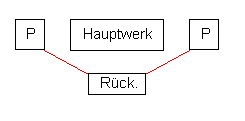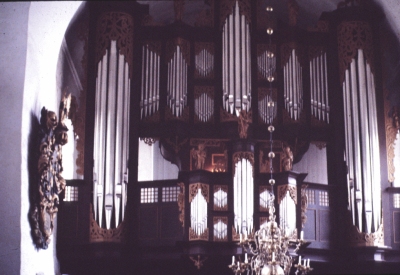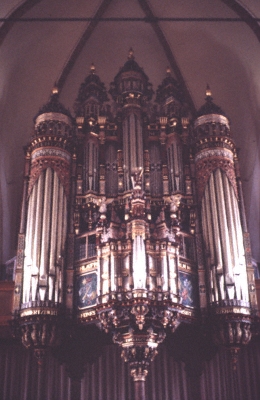Werkprinzip Organs
The term Werkprinzip is one that is sometimes confusing to organ students in the United States. One of the first steps in understanding what the word means is to remember that the term was invented in the twentieth century. It's how we label certain instruments of the past, not how they labeled them. The term was invented to conveniently describe certain characteristics of organs built in the late seventeenth century, usually organs from north Germany. Translated literally, the word means "work principle," or "principle of works," or some such combination. The confusion begins to clear a little if you realize that a Werk is in this context a German "division." In what may be for German words an unusual shortcut, Prinzip means here a "principle of relationship between" divisions, or maybe "principle of balance between" divisions. So - - if you read about Werkprinzip organs, the writer is talking about an instrument in which the nature of different divisions and their relationship to one another is considered an important identifying characteristic.
In seventeenth-century German organs, particularly those from the north, the nature of this balance was somewhat standardized. Typically, an organ of this time and place had 141
- A Hauptwerk that contained the primary principal chorus, flutes, and trumpets. The sound was rich and full.
- A Rückpositiv that had a secondary principal chorus, additional flutes, and a short-resonator, cylindrical reed (often a Krummhorn). The pipes of this division were built with narrower scales, resulting in a more penetrating quality.
- A Brustwerk that contained the lightest stops, often only flutes and reeds, with a high-pitched mixture meant for solo color, not ensemble use.
- A Pedal that had its own independent principal chorus and reeds, and it might also contain stopped flutes at 32' through 8' pitches. The Pedal was divided and mounted on the gallery rail, to the sides of the positive, where it served two distinct functions:
- Providing the bass line in ensemble textures based on a principal chorus.
- Providing solo color in melodic textures.
You don't need to think that all these components were found in all the organs of the period.
- Smaller organs might not have all the divisions.
- An Oberwerk might be one of two things:
- The primary division, simply called Oberwerk rather than Hauptwerk, since either term might refer to a division above the Brustwerk.
- A third manual division placed above the Hauptwerk rather than a Brustwerk placed below it, or in addition to both Rückpositiv and Brustwerk in a four-manual organ.
- In some organs, the Pedal was divided on four chests, so that the stops that provided a bass line were divided in towers on the gallery rail, while solo, melodic stops were divided on separate chests in the Brust position of the main case.
One important thing to notice here is the relationship between the overall components of a Werkprinzip organ and the same characteristics as we see them in some earlier instruments. If you look back at the "Praetorius Organ," you will see that most of the characteristics listed above are also present in the Groningen Court Chapel organ. 193 The great organs of late seventeenth century north Germany are indeed descendants of older organs built in the lowlands. In organs of the later seventeenth century, we can find the same characteristics listed above, but they were concentrated and reduced to the essentials in later instruments. For example, although the primary manual division of the "Praetorius organ" had multiple flutes at 8' pitch, the typical instrument of the late seventeenth century had only one. Similarly, the variety of colors at 4' pitch on the secondary manual (Rückpositiv) was normally reduced in later instruments to two stops, one of which served the principal chorus. Similarities remain, of course. From the standpoint of historical development, two points about the Werkprinzip organ need to be remembered.
- The list above represents a systematic approach to building organs and distributing different stops over several divisions.
- The system for doing this evolved from earlier practices in the lowlands.
Another aspect of the Werkprinzip organ is the matter of pitch relationships among the principals of each division. Typically each division was based on a Prinzipal of a different pitch, with the lowest being found in the Pedal, the next in the Hauptwerk, the next in the Rückpositiv, and so on. In fact, it became standard practice in the middle of the twentieth century to talk about such organs as "8' organs" or "16' organs," using the pitch level of the primary manual Principal stop as a name. Each division would then have another principal stop an octave above each Prinzipal, another stop above that, and each chorus would be topped off with one or two mixtures. This table lists the names and pitch levels of principas on two hypothetical organs built according to this concept:
|


 The photograph also shows what appears to be two flats connecting the main case to the pedal towers. These are not functional pipes, and were added in the eighteenth century just to connect the three separate cases that appeared in a row. The diagram to the right shows the floor plan for this layout of four cases. The "footprint" of the main case, which includes both the Hauptwerk and Brustwerk divisions of this particular organ, is simply labeled "Hauptwerk." The two flanking rectangles labeled "P" house the divided pedal division, while the rectangle marked "Rück." holds the Rückpositiv. The red lines indicate the angled line of the gallery rail, which not only provides a projection for the Rückpositiv but also allows space for the organist to sit!
The photograph also shows what appears to be two flats connecting the main case to the pedal towers. These are not functional pipes, and were added in the eighteenth century just to connect the three separate cases that appeared in a row. The diagram to the right shows the floor plan for this layout of four cases. The "footprint" of the main case, which includes both the Hauptwerk and Brustwerk divisions of this particular organ, is simply labeled "Hauptwerk." The two flanking rectangles labeled "P" house the divided pedal division, while the rectangle marked "Rück." holds the Rückpositiv. The red lines indicate the angled line of the gallery rail, which not only provides a projection for the Rückpositiv but also allows space for the organist to sit!
